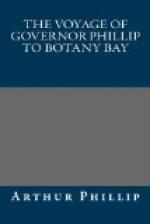The length of this species is from sixteen to eighteen inches: the bill, three inches and an half, or even more; the upper mandible is brown, and the under white, but brown at the base: the head is pretty full of feathers, sufficiently so to form a crest when erected; the colour whitish, and most of the feathers either tipped or crossed with black: the neck and under parts of the body are much the same in colour, crossed on the sides with dusky lines: over the forehead the colour is dusky brown, almost black, passing backwards in an irregular shaped streak a good way behind the eye: the back, and major part of the wing, is black or dusky, but the middle of the wing is of a glossy blue-green, as is also the lower part of the back and rump: the tail is barred with pale rust-colour and black, inclining to purple, and towards the end whitish: the legs are of a dusky yellow, the claws are black.
These birds vary much, the colours being more or less brilliant, and in some of them the tail is wholly barred with white and black, and the legs brown or blackish.
This species inhabits various places in the South Seas, being pretty common at New Guinea; but the specimen from which our figure was taken, was sent from Port Jackson in South Wales, where, likewise, it is not unfrequently met with. We believe it has not yet been figured in any British work.
Kanguroo.
This very curious animal being naturally an object of particular curiosity, we are happy to be enabled, before this book is given to the world, to correct some errors which had crept into our account and representation of it. In page 149 it is stated, that the Kanguroo has four teeth (by which were meant cutting teeth) in the upper jaw, opposed to two in the under. The truth is, that there are six opposed to two, as may be perceived in the engraved representation of the skeleton of a Kanguroo’s head, inserted at page 168. The same arrangement of teeth takes place in the Opossum, described in that page, which is there, still more erroneously, said to have only two cutting teeth opposed to two. This latter mistake arose from the difficulty of examining the mouth of the living animal. It is since dead, and the teeth are found to be disposed as now stated, and as represented in the scull of the Vulpine Opossum, in the same plate with that of the Kanguroo.
But the most important error is in the position of the Kanguroo, as represented in our plate at page 106. The true standing posture of the Kanguroo is exactly the same as that of the Kanguroo Rat, delineated at page 277; namely, with the rump several inches from the ground, (in large specimens, not less than eight) and resting entirely on the long last joint of the hinder legs, the whole under side of which is bare and callous like a hoof. This mistake was occasioned merely by the adherence of the engraver to the drawing from which he worked; which, among others, came from Mr. White, the surgeon at Port Jackson: too implicit reliance being placed on an authority which, in this respect, turned out delusive.




